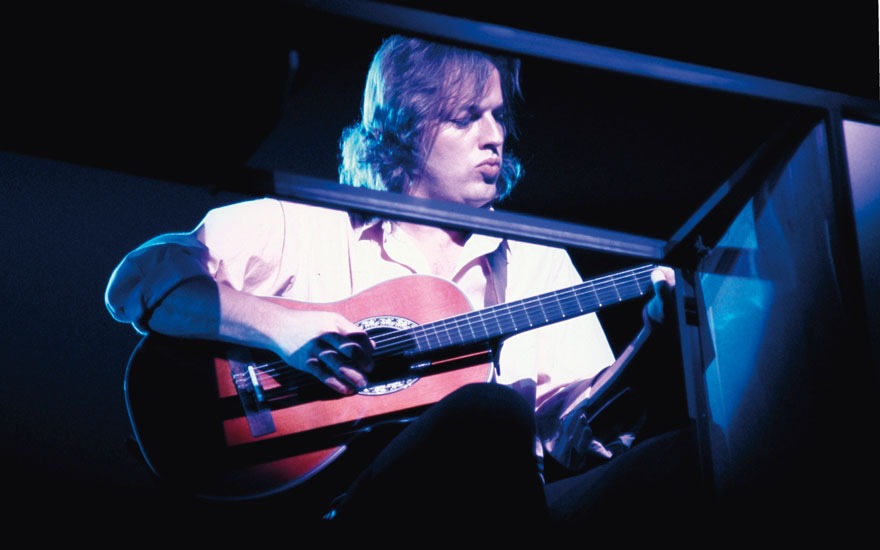
The Seventies were still in their infancy when David Gilmour turned onto Music Row, West 48th Street in Midtown Manhattan. The area near Times Square was a thriving hub for musicians who came to buy and sell instruments, and one of its most popular haunts was the famed Manny’s Music store, which had been in business since 1939.
‘It was legendary,’ confirms Gilmour, who had purchased his iconic ‘Black Strat’ from Manny’s just the year before. ‘It was a very New York experience — the sort of thing we English boys had seen in films. It’s hard to describe, but it was a wonderful place.’ As well as being lined with guitars, the shop’s walls were plastered with many thousands of autographed publicity shots of famous musicians, including Buddy Holly, Johnny Cash, Bob Dylan, The Who and The Beatles, who all made a beeline for Manny’s whenever they hit town.
Gilmour had gone in search of a new acoustic guitar, but before he had even made it through the door of Manny’s he was approached on the street by a musician who was hawking a Martin D-35. The Pink Floyd singer and songwriter took a look, liked what he saw, and liked what he heard even better. He bought the guitar on the spot. Little was he to know then that the instrument would go on to spend decades as his primary studio acoustic for both Pink Floyd and his solo recordings.

C.F. Martin & Company, Nazareth, 1969. An acoustic guitar, D-35. Estimate: $10,000-20,000. Offered in The David Gilmour Guitar Collection on 20 June 2019 at Christie’s in New York
More than 30 years after that chance encounter on the streets of New York, Gilmour was asked by Guitar Player magazine which of his many guitars had most songs attached to it. ‘I guess it would be my Martin D-35,’ he replied. In the same year, 2003, Gilmour was a guest on Desert Island Discs, the long-running BBC Radio 4 show. When host Sue Lawley inquired what his luxury ‘desert island’ item would be, Gilmour said that he would take his Martin D-35. ‘To me it’s not a luxury,’ he explained, ‘it’s an essential… Life is impossible without a guitar.’
David Gilmour’s Martin D-35 is immortalised for its part in Wish You Were Here, the classic title track of Pink Floyd’s 1975 follow-up album to The Dark Side of the Moon. Along with Shine on You Crazy Diamond, which bookended the album, the ballad is inspired by Pink Floyd founder member Syd Barrett, who left the band in 1968.
‘Although Shine on You Crazy Diamond is the one that is specifically about Syd and Wish You Were Here has a broader remit, I can’t sing it without thinking about Syd,’ Gilmour explained in the 2012 documentary about the making of the album. ‘Because of its resonance and the emotional weight it carries, it is one of our best songs.’
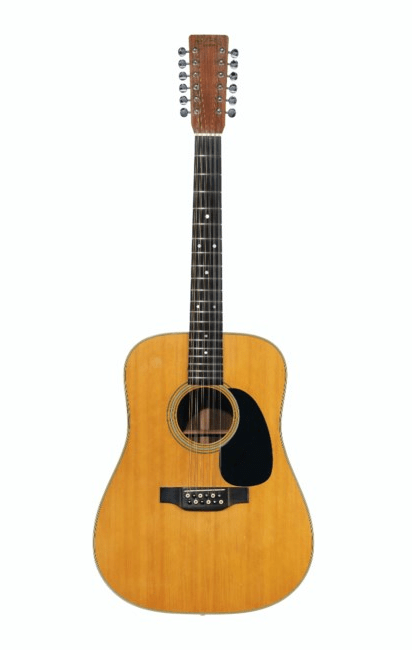
C.F. Martin & Company, Nazareth, 1971. An acoustic guitar, D12-28. Estimate: $5,000-10,000. Offered in The David Gilmour Guitar Collection on 20 June 2019 at Christie’s in New York
The opening riff was actually composed on another Martin acoustic, a D12-28 12-string guitar that Gilmour had bought from a friend in 1974. In the first half of the following year, Pink Floyd were working on their new album at Abbey Road Studios in London when Gilmour hit upon the notes that would become the enduring title track.
‘I was strumming it in the control room at No.3… and that just started coming out, that riff,’ he told the musicologist Paul Rappaport. ‘I started mildly obsessing with this riff that was slowly developing and, again, people’s ears — Roger’s [Waters] ears — pricked up.’
The song opens with the sound of a car radio, which was recorded in Gilmour’s car. He played the intro on the Martin D12-28 12-string, processed to sound like it was playing through an AM radio, before overdubbing a fuller-sounding acoustic guitar solo on the D-35. This passage was then mixed to sound as though a guitarist were listening to the radio and playing along.
‘Every time I listen to the actual original recording, I think, “God, I should have really done that a little bit better,”’ he says. ‘It wasn’t supposed to be too slick… and it wasn’t.’ The track, which Gilmour rates as one of Pink Floyd’s best, is ranked among Rolling Stone’s greatest songs of all time.
Acoustic influences
David Gilmour’s love affair with 12-string acoustic guitars dates back to his teenage years, when he listened to and learned from American folk and blues singers such as Lead Belly, whom he describes as ‘a great 12-string player’. Other early acoustic influences included Erik Darling, who recorded an album that Gilmour remembers being ‘very, very fond of back in those days’.
Like pretty much every other youngster in the mid-1950s, Gilmour grew up to the soundtrack of rock’n’roll. But as well as having his imagination fired by Bill Haley’s Rock around the Clock, Elvis Presley’s Heartbreak Hotel and the Everly Brothers’ Bye Bye Love, he was also heavily influenced by the more acoustic sounds of blues and folk music. His parents had brought back a stack of folk and blues 78s from a trip to America, and alongside the new idols of rock’n’roll, the young Gilmour hungrily devoured the music of Pete Seeger, Woody Guthrie, Big Bill Broonzy and John Fahey, among others.
When Gilmour was 15, his parents moved to America for a period. Opting to stay behind, he lodged with a family and frequently sneaked out to watch gigs when he should have been studying. His parents sent over Bob Dylan’s debut record from the United States, and Gilmour saw the singer’s first show in England in December 1962.
Gilmour confesses that many of the guitars he has purchased over the years have joined his collection because he had seen them played by musicians he admired. One such example, which has links back to his early days in Cambridge, is an acoustic guitar by Dick Knight.
Rado Klose was a very early member of the band that became Pink Floyd, and he and David Gilmour had been friends since infancy. Gilmour has described Klose as ‘a brilliant guitar player’ and recalls his arch-top, F-hole, jazz-type acoustic guitar by Dick Knight being a source of envy when he first began playing in the late 1950s.
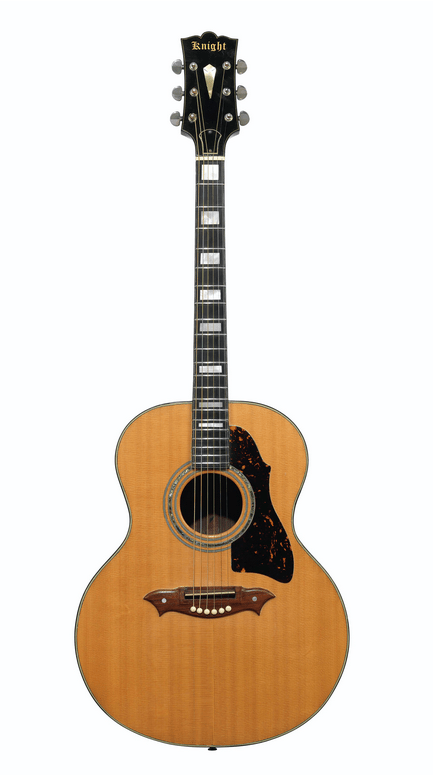
Dick Knight, Surrey, 1969. An acoustic guitar. Estimate: $2,000-3,000. Offered in The David Gilmour Guitar Collection on 20 June 2019 at Christie’s in New York
More than a decade later, when David Gilmour had recently become a member of Pink Floyd, he decided to track down Dick Knight. A jazz guitarist of some repute, Knight had sliced off all the fingers on his left hand while working as a machinist and woodworker. He could no longer play but he was still building guitars, and in 1969 Gilmour went to meet him in Addlestone in Surrey. Giving Knight his list of specifications, he asked the luthier to make him a guitar — ‘because I had liked Rado’s one so much’, he says.
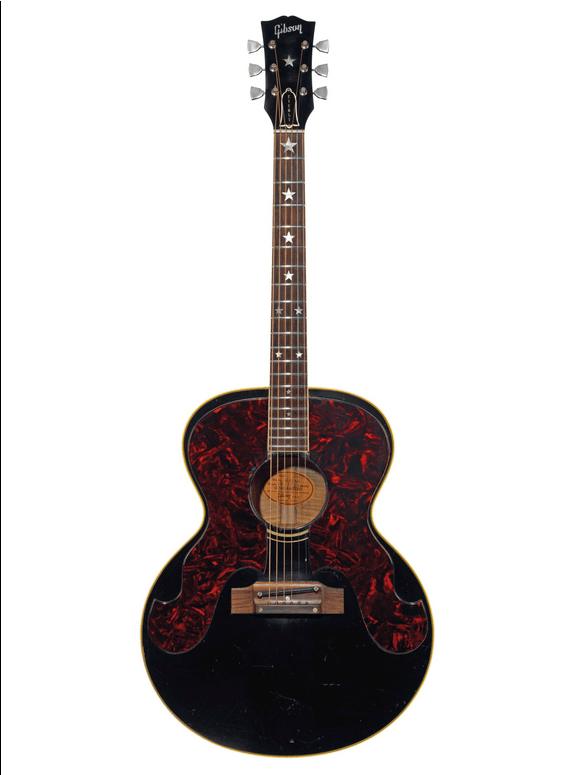
Gibson Incorporated, Kalamazoo, 1963. An acoustic guitar, Everly Brothers, J-180. Estimate: $10,000-15,000. Offered in The David Gilmour Guitar Collection on 20 June at Christie’s in New York
Another guitar with links to his early days is a J-180 Everly Brothers acoustic, which Gilmour purchased in March 1979 from George Gruhn of Gruhn Guitars in Nashville, Tennessee. He had long been an admirer of the Everly Brothers with their black acoustics, and this was a guitar that Gibson had produced in 1962 at the specific request of Don and Phil Everly.
Gilmour recalls using the guitar during recording of the 1979 Pink Floyd album The Wall at Producers Workshop in Los Angeles between September and early November 1979, although it is not known whether it made it onto the final record.
Iconic acoustics in the story of Pink Floyd
In 1985, the Gibson Company commemorated its 90th anniversary by producing a limited run of 90 J-200 Celebrity guitars. The outline was based on one of the most iconic American guitars ever produced, the J-200. Rather than maple for the back and sides, the Celebrity was built incorporating East Indian Rosewood for the richer and warmer overtones that it produced. The following year, David Gilmour tried out a J-200 Celebrity belonging to John Illsley of Dire Straits, while at Air Studios in London.
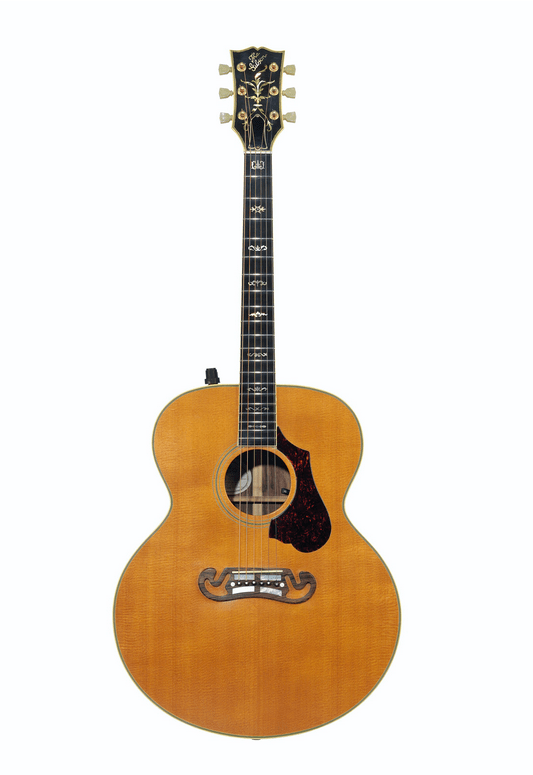
Gibson Incorporated, Nashville, 1986. An acoustic guitar, J-200 Celebrity. Estimate: $3,500-5,500. Offered in The David Gilmour Guitar Collection on 20 June 2019 at Christie’s in New York
Gilmour liked it immediately. ‘I contacted Gibson and asked if they had any left,’ he explained in a 2006 interview. ‘They were looking in their storeroom and they found one that had somehow never reached its destination. And they let me have it.’
The J-200 Celebrity was used extensively on the 1994 Pink Floyd album The Division Bell. Gilmour acquired Illsley’s J-200 Celebrity in the same year, as he needed more than one for the subsequent tour. Later, he would select the J-200 Celebrity for a performance of Wish You Were Here at the Live 8 concert in London’s Hyde Park, which saw the historic reunion of the classic-era Pink Floyd line-up for their first performance together in 24 years.
One of David Gilmour’s longest-serving instruments, which was carried on every Pink Floyd and solo tour from 1977 and played by both Gilmour and Roger Waters, was famously used to write and record the original demo that became Comfortably Numb. The Ovation Custom Legend 1619-4 was acquired in October 1976, one of a group of Ovation acoustics purchased in advance of Pink Floyd’s tour in support of the 1977 album, Animals. Both Gilmour and Waters relied on Ovations for touring because of their sturdiness and built-in electronics.
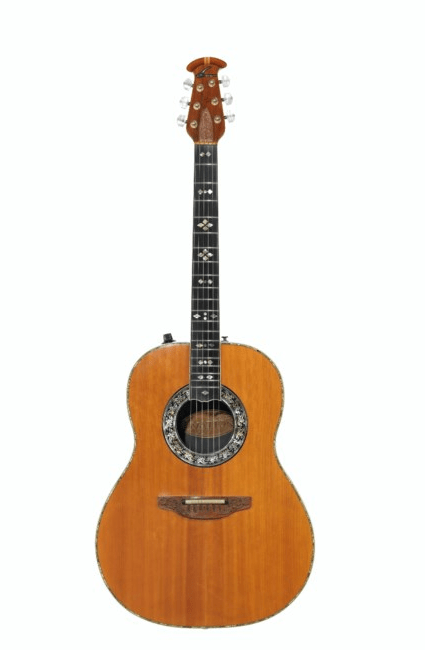
Ovation Instruments, New Hartford, 1976. An acoustic-electric guitar, custom legend, 1619-4. Estimate: $3,000-5,000. Offered in The David Gilmour Guitar Collection on 20 June 2019 at Christie’s in New York
Gilmour refers to this Ovation as being ‘hi-strung’, having invented his own variation of ‘Nashville’ or high-strung tuning on this guitar in late 1977, which produced an ethereal, crystalline sound. ‘I had some friends working in Abbey Road on an album with Bruce Welch [the rhythm guitar player in The Shadows] producing them,’ he explains. ‘They had put down a couple of acoustic tracks that he said he wanted to double-track with a high-strung to thicken the sound of the acoustics. They told me that it was a guitar tuned higher with different strings on it, but they didn’t know how it was tuned.
‘I decided to work on my own version of it, so I put these different gauge strings onto one of these Ovations. I started playing with that, strumming away and realising that you couldn’t really go wrong.’
Gilmour refers to this Ovation as being ‘hi-strung’, having invented his own variation of ‘Nashville’ or high-strung tuning on this guitar in late 1977, which produced an ethereal, crystalline sound. ‘I had some friends working in Abbey Road on an album with Bruce Welch [the rhythm guitar player in The Shadows] producing them,’ he explains. ‘They had put down a couple of acoustic tracks that he said he wanted to double-track with a high-strung to thicken the sound of the acoustics. They told me that it was a guitar tuned higher with different strings on it, but they didn’t know how it was tuned.
‘I decided to work on my own version of it, so I put these different gauge strings onto one of these Ovations. I started playing with that, strumming away and realising that you couldn’t really go wrong.’
Set up as a hi-strung, the guitar can be definitively placed in the January 1978 recording sessions for Gilmour’s eponymous debut solo album at Super Bear Studios in the South of France, although there are no records as to whether it was used on any of the tracks. What we do know, though, is that late on in the sessions Gilmour came up with a chord sequence and rough melody while strumming on the hi-strung Ovation that would, with the collaboration of Roger Waters, evolve into the Pink Floyd masterpiece Comfortably Numb.
Pink Floyd returned to Super Bear in April 1979 to begin recording their narrative concept album The Wall. At the suggestion of co-producer Bob Ezrin, Gilmour’s instrumental demo was presented to the rest of the band, and Waters was encouraged to come up with a set of lyrics. Gilmour re-enlisted the hi-strung Ovation, on which he had composed the initial music, to record his acoustic guitar parts on the track, before coming in with his landmark solos on the Black Strat.
Back to his acoustic roots
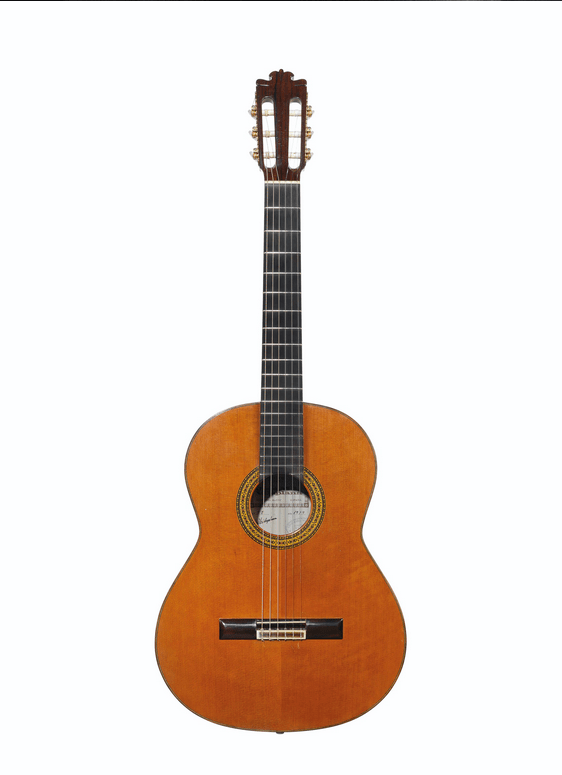
Jose Ma. Vilaplana, Muro del Alcoy, 1979, an acoustic guitar. Length of back 19⅝ in (49.7 cm). Estimate: $2,500-3,500. Offered in The David Gilmour Guitar Collection on 20 June 2019 at Christie’s in New York
While David Gilmour will always be synonymous with ‘The Black Strat’, his acoustic roots have never been far from the surface. On High Hopes, a nostalgic evocation of his early days in Cambridge and the closing track on Pink Floyd’s 1994 album The Division Bell, Gilmour played a classical acoustic guitar by José María Vilaplana.
Phil Manzanera, co-producer on Gilmour’s 2006 solo album On an Island, remembers how immersed he became in his acoustic sound and how difficult it was to get him back into the studio with an electric guitar. ‘A lot of the early stuff was very acoustic,’ he said. ‘We almost entered into English folk territory.’
In other words, similar territory to where it all began, and where it’s still at, for one of the world’s greatest guitarists. ‘I’m never more than about 20 feet from a guitar,’ Gilmour admits. ‘I pick one up and play one every day, mostly acoustics, because they make a nicer noise in the room.’
